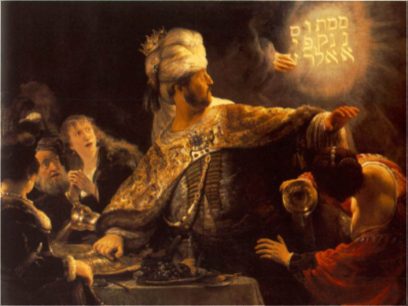Daniel 5: Five Moves
Raiders of the Lost Artifacts
 Rembrandt, The Feast of Belshazzar (1632) |
Gods Graffiti
Calling Daniel
Read It and Weep
 Aramaic - Hebrew Words
Aramaic - Hebrew Words
To understand the cryptogram you have to understand a little about how Hebrew words work. Most words come from a three letter root. Hebrew has no true vowels. So different vowel sounds change the meaning of the words. One root word can be read numerous ways.

MENE MENE TEKEL UPARSIN
The text only gives us the letters that make up the message. But these words are not evident until Daniel decodes it. Why cant the other diviners read the message?
This is where the theory about the cryptogram comes up. What if the letters were arranged in an unusual and atypical way?

There is a legend that the inscription was written in columns. That is the way Rembrandt pictured it in his 1632 painting. He learned this interpretation from his friend Manasseh ben-Israel in Amsterdam.
The color changes above show how the four words (including the ![]() for and) could be arranged.
for and) could be arranged.
More importantly is the how the words have double meaning depending on whether it is a noun or verb. This chart describes how Daniel understands the riddle.

The Pun Intended
So, Daniel is assuming that the riddle refers to an assortment of coins, but also functions as a prophecy of doom on Belshazzar.
The riddle Mina, Mina, Tekel and Parsin (using our common coinage) might read something like Half a dollar, half a dollar, a penny, and two bits
What is means (as Daniel explains very well in the text) is: Your days are numbered, your rule has been weighed, and your empire will be divided among the Medes and Persians
It isnt accidental that the word for half-mina can also be read as Persia.
The aftermath is reported as Belshazzars immediate fall and the conquest of Persia. A new ruler is in charge of Babylon. The mighty have fallen.
So What?
 Link to next sermon
Link to next sermon
 Link to other sermons of Chris Benjamin
Link to other sermons of Chris Benjamin